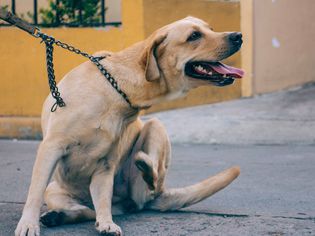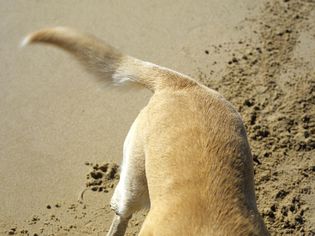Neosporosis is a neuromuscular disease caused by infection with a protozoan, which is a one-celled organism. Although many infected adult dogs do not have any symptoms, the disease is still potentially very serious as it can cause paralysis of the hind legs, inflammation of internal organs, and even death in some dogs. Puppies are particularly susceptible to the disease and likeliest to have severe symptoms.
Dogs that live on farms or in rural areas are at the greatest risk of infection, as the protozoan responsible for the disease typically infects cattle, sheep, goats, and other domesticated animals. It can also infect wild animals, including deer. Dogs catch neosporosis by eating raw meat or other tissues from an infected barnyard or wild animal.
What Is Neosporosis?
Neosporosis is a complex disease that affects not just dogs, but also cattle and similar herbivores. A protozoan called Neospora caninum is the cause of this condition. In dogs, neosporosis can cause paralysis and death in puppies, and organ, skin, and brain inflammation in adult dogs. In infected cattle and similar herbivores, the disease commonly causes spontaneous loss of pregnancy.
Symptoms of Neosporosis in Dogs
Many adult dogs don't show symptoms of neosporosis, despite infection. However, an infected female dog can pass the disease to her unborn puppies or to the puppies through her milk once they are born. Infected puppies are the likeliest to show severe symptoms, including paralysis. Symptoms in adult dogs include inflammation throughout organ systems, including the skin.
Puppies who become infected with neosporosis before birth are the most severely infected. In these animals, symptoms can start within 3 to 9 weeks after birth. Typically, these puppies develop progressively severe rigidity and paralysis in the hind legs, which can eventually affect the forelegs as well. The puppy's muscles become weak and it has difficulty breathing and swallowing. Most of these dogs do not survive.
In older dogs that develop neosporosis, symptoms typically come from organ system inflammation, which can include pneumonia or liver inflammation. Signs of brain and spinal cord inflammation include staggering gait, head tilt, tremors, and abnormal eye movements. Sores and skin inflammation are also common in adult dogs with neosporosis.
Causes of Neosporosis
The protozoan Neospora caninum is the culprit that causes neosporosis. It is closely related to Toxoplasma gondii, another protozoan that causes the disease toxoplasmosis, which can infect dogs, cats, and many other animals, including humans.
Dogs and other canids, including coyotes and wolves, are the definitive host for the parasite, meaning that N. caninum requires a dog to complete its lifecycle. The organism gains access to the host when the dog eats raw meat, fluids, or placenta from an infected intermediary host, which is generally a cow, goat, sheep, deer, or similar animal. Once ingested, the protozoan reproduces in the intestinal system of its dog host, creating oocysts, which are similar to eggs. The oocysts then pass from the dog in its feces.
If a cow or similar mammal consumes the oocysts while grazing, the cow becomes infected with the protozoan. N. caninum is a major cause of cattle miscarriage worldwide, and thus is of great concern to farmers and ranchers. Sheep and goats can also experience miscarriage if infected with the organism.
As many as 7 percent of pet dogs in the United States test positive for exposure to N. caninum, although the majority of those dogs don't ever have any symptoms of infection. However, in some adult dogs, for reasons that are not well understood, occasionally the protozoan causes inflammation and lesions in the dog's nervous system and other organ systems. The disease is far more severe in puppies infected before birth.
Diagnosing Neosporosis in Dogs
Diagnosis is typically made by a veterinarian after performing a full physical examination, obtaining a full history of the dog, and recognizing the symptoms of the disease. A special titer test using blood or spinal fluid will also be run to look for evidence of exposure to the parasite. Despite the fact that this parasite lives in the intestinal tract, there is rarely any evidence of N. caninum in the feces of a dog during a routine fecal examination.
Treatment
Neosporosis is difficult to treat. Generally, symptomatic dogs receive a long course of antibiotics, often Clindamycin twice daily for a month. If symptoms don't improve rapidly, the antibiotics are continued for up to two weeks after symptoms plateau. If a young puppy is being treated, its littermates will be treated as well, even if they are not displaying symptoms.
Antibiotic treatment is to slow or resolve symptoms. Antibiotics do not cure or eliminate the underlying infection with N. caninum. Even after treatment, a female dog can transmit the infection to its puppies.
Prognosis for Dogs with Neosporosis
Unfortunately, the prognosis is very poor for puppies born with neosporosis or that develop it shortly after birth. Most will die with or without treatment. However, in older dogs, those with mild symptoms who receive prompt treatment may survive. Dogs with severe symptoms have a poor prognosis, though, even with treatment.
How to Prevent Neosporosis
There is no vaccine to prevent neosporosis in dogs or in cattle. Therefore, if your dog lives on a ranch or other area with cattle, hunts or roams woods inhabited by deer, or spends time in close proximity to sheep or goats, it is important to take care that the dog does not consume raw meat, afterbirth, or fluids from these animals.
As another precaution, dogs that test positive for exposure to neosporosis should never be bred so as to prevent passing this infection to the litter of puppies, even if the female dog shows no symptoms or has been treated with antibiotics.
Is Neosporosis Contagious to Humans?
Thankfully, neosporosis is not considered a zoonotic disease, as it is not thought to spread to humans from infected animals. Some humans have had positive titers for N. caninum without being sick, though, so immunocompromised people should be careful if they come in contact with a dog or other animal that is infected in case it could cause a problem for them.








